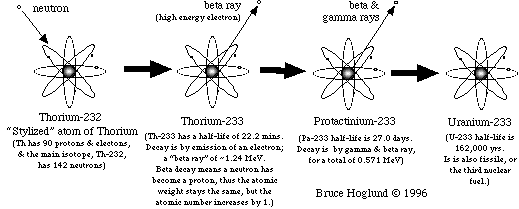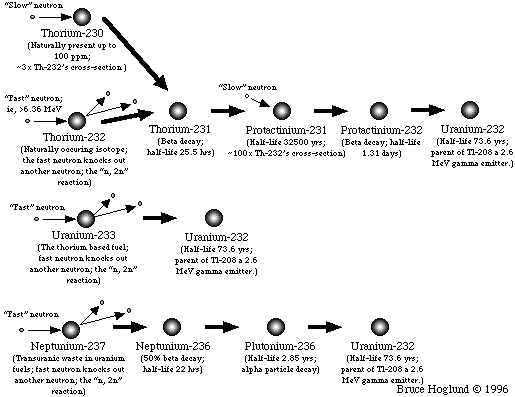
Chemical Symbol is: Th
(facts below taken from Encyclopaedia Britannica CD 97, unless otherwise noted)
Thorium reacts slowly with air at room temperature to form a film (tarnish) of thorium dioxide (ThO2 - sometimes also called "Thoria"). Unlike uranium dioxide (UO2), thorium dioxide is the only stable oxide of thorium, which accounts for the greater stability of Thoria versus uranium dioxide. Thorium dioxide is also much more resistant to chemical interactions, which is demonstrated by its uses as a high temperature crucible (container) or in the gas mantle (used in "Coleman" camping laterns) invented in 1885 by Welsbach; which is a fabric soaked with a mixture of thorium nitrate and cerium nitrate, which upon ignition becomes a 99% Thoria "mantle" that glows white-hot when heated by a gas flame.
For nuclear applications, also important are thorium's radiation stability and thorium dioxide's higher thermal conductivity. These properties suggest thorium fuels have greater potential safety and fuel durability than the currently used uranium dioxide or even "MOX" (Mixed Oxide Fuels - formed by a mixture of plutonium dioxide, PuO2, & uranium dioxide) nuclear fuels.


1. CRC Handbook of Chemistry & Physics, 53rd Edition, page B-507. (Back)
2. The ratio of Th230:Th232 can be calculated by:
Th230/Th232 = 1.76 x 10-5 * rU,Th.
Pgs 284 & 378, "NUCLEAR CHEMICAL ENGINEERING", Benedict, Pigford, & Levi (1981). Also, Page 515, "NUCLEAR REACTOR ENGINEERING", Glasstone & Sesonske (1981). (Back)
3. 53rd Ed. CRC Handbook of Chem. & Physics. (Back)